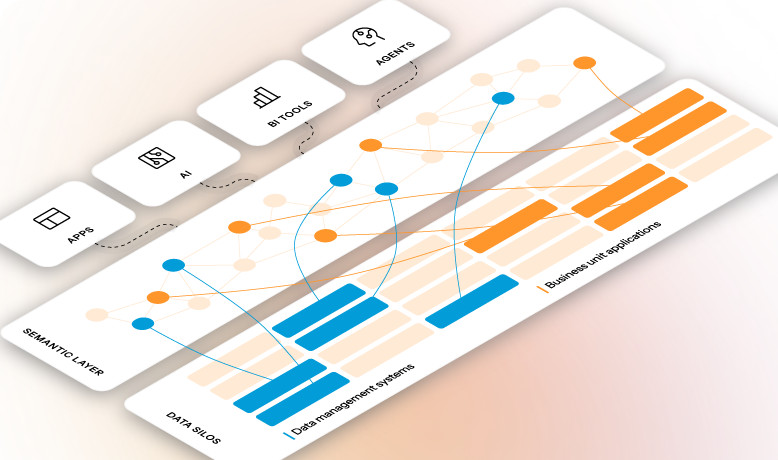
Unlocking AI-Ready Data: Why Does a Semantic Layer Matter?

Building Scalable, AI-Ready Data Starts With a Semantic Foundation.
A semantic layer provides the missing link between today’s AI ambitions and the trust, transparency, and accuracy those initiatives require to succeed.
At the heart of the challenge is what we call the AI 'context gap'. This gap represeants the disconnect between what AI models see in the data and what humans need them to understand. It single handedly closes the context gap by grounding AI in meaning and understanding. It acts as a bridge between messy, siloed, and fragmented enterprise data and real-world applications.
Instead of guessing or hallucinating, GenAI models equipped with a semantic layer understand what data actually represents within the organization’s unique context. It’s the foundation that transforms raw information into usable knowledge.
With poor ROI and expectations around AI initiatives often slipping into the 'trough of disillusionment', a semantic layer changes the equation. It turns raw data into usable knowledge that is consistent, transparent, and trustworthy. And once that foundation is in place, a wide range of high-value use cases open up:
- Agentic AI: A foundational component of an agentic architecture, providing a shared semantic infrastructure that keeps AI agents aligned, interoperable, and operating with the same trusted definitions.
- Collaborative AI Agents: Multiple AI applications sharing a common foundation and staying grounded in an agentic framework.
- Advanced AI & LLMs: Contextualized, reliable data reduces hallucinations and boosts accuracy.
- 360° Operations: Silos are broken down for a true 360° view of operations and customers.
- Predictive & Prescriptive Analytics: Reliable forecasts and smarter recommendations.
- Natural Language Querying: Non-technical users ask questions in plain language—and get precise answers.
- Self-Service Analytics: Business users create dashboards and insights without IT bottlenecks.
- Governance & Compliance: Metrics, lineage, and access rules stay consistent.
- Explainable Insights: Traceable data lineage builds trust in both AI and analytics outputs.
From BI to AI: A Coming-of-Age Moment
It might come as a surprise that the idea of a semantic layer first emerged in the 1990s, born in the business intelligence (BI) and data warehousing circle. The concept was simple but transformative: bridge the gap between complex databases and the business users who needed to make sense of them.
BusinessObjects popularized the concept with its Universe feature, which allowed users to query and explore data in plain business language, without needing to know SQL or database structures (txt2sql).
As enterprises look to unlock real value from AI, the semantic layer is poised to have its moment. Not just as a translator of data, but as the connective tissue that grounds AI in business context and delivers the ROI and scale required for widespread adoption.
How a Semantic Layer Works
At its core, a semantic layer acts like a universal translator. It sits firmly sandwiched between the raw data sources and the applications providing much needed contextualization and meaning of the data. By leveraging meta data, a rich knowledge graph of an organization is built.
Here’s how it works in practice:
- Define Business Concepts
Technical fields like cust_id or txn_amt are mapped to familiar business terms such as Customer or Revenue, creating a shared language across the organization.
- Abstract the Complexity
Users no longer need to write SQL queries or navigate complex data warehouses. They interact with clear definitions like Net Revenue or Active Customers, while the semantic layer handles the technical work behind the scenes.
- Connect Data Across Sources
Enterprises pull data from dozens of systems—ERP, CRM, HR, marketing platforms. The semantic layer stitches these together, producing a unified view that reflects how the business actually operates.
- Apply Governance and Rules
Definitions are standardized across the organization. Revenue means the same thing in Finance as it does in Sales, ensuring consistency and trust.
- Enrichment
The semantic layer doesn’t just act as a translation layer but also an enrichment layer by adding meaning and functionality to raw data. Metadata descriptions and prompt instructions giving context to LLM to avoid hallucinations and improve accuracy.
- Fuel AI and Analytics
Clean, unified data powers faster insights for analytics dashboards and more accurate, explainable outputs for AI models.
The semantic layer doesn’t replace your data systems. It makes them usable, trustworthy, and AI-data ready.
Why Semantic Layers Matter Even More in an Agentic AI Era
In an agentic AI architecture, the need for a centralized layer becomes even more critical. Under the hood a small fleet of task rabbits are being unleashed, and they need a zookeeper.
One centralized layer (A.K.A. semantic knowledge graph) allows each one of these task rabbits to access the same knowledge base, creating shared understanding of the unique and important nuisances of your organization.
Remember that without grounding, AI-generated insights can be disconnected, incomplete, or even wrong. A semantic layer addresses this challenge:
- Bridging Human and Machine Language: Just like in the ’90s it bridged SQL and business terms, today it bridges LLM prompts with meaning. “Revenue by customer segment” now produces accurate, reliable answers.
- Context and Accuracy: Nearly 80% of enterprise data is unstructured—emails, documents, PDFs, notes. A semantic layer unifies this with structured data, giving AI the context it needs.
- Transparency and Trust: Modern semantic layers go beyond simple definitions, adding lineage, governance, and explainability to increase confidence in AI outputs.
- Scalability Across AI Agents: As organizations deploy multiple AI agents, a semantic layer provides a shared foundation, ensuring consistent, aligned insights.
Reasoning (Think Natural Language Querying) Without a Semantic Layer
You can’t have reasoning without meaning. The semantic layer is the foundation (what the data means across all your data (not guess a point solution)) and the reasoning layer is the brain (how to use that meaning to reach a conclusions). In practice, modern AI architectures often need both.
- The semantic layer ensures that Revenue is defined consistently across the business.
- The reasoning layer applies logic: If revenue declines three quarters in a row and churn rate is above threshold X, flag early warning for customer attrition.
Why App Orchid Leads the Way
At App Orchid, our semantic knowledge graph sets the standard for scalability and accuracy. By providing context to LLMs, we increase the likelihood of successful Gen AI initiatives. Accuracy is non-negotiable—without it, nothing else matters. App Orchid isn’t just keeping pace with the conversation; we’re leading it.
While many foundation models continue to plateau on the BIRD dataset, App Orchid is breaking through. Our preliminary results show 94.2% accuracy on the BIRD Dev set after ontology enrichment, a leap that is not incremental, but transformative.
App Orchid is being tested across the entire 12,751 question-SQL pair benchmark, covering 95 databases and 37 professional domains. These results position App Orchid not just as a contender, but as a category-defining leader in enterprise-grade GenAI.


The Best Path to
AI-Ready Data
Experience a future where data and employees interact seamlessly, with App Orchid.

